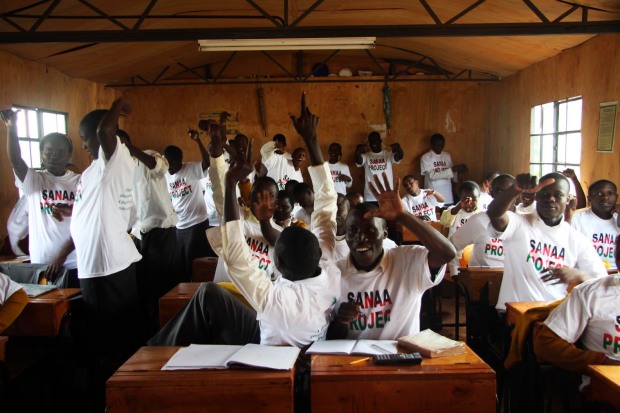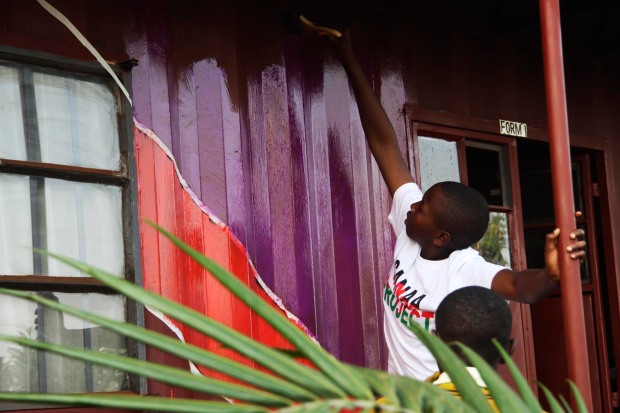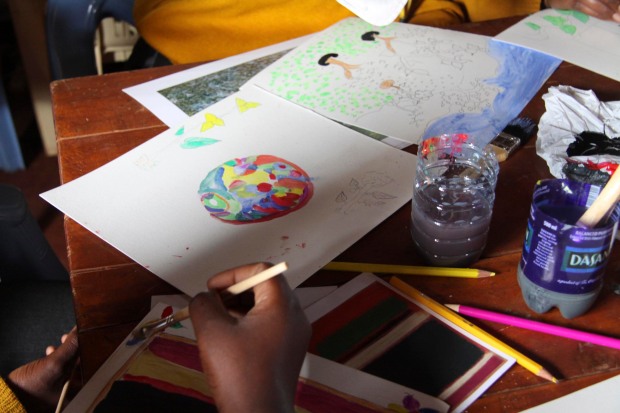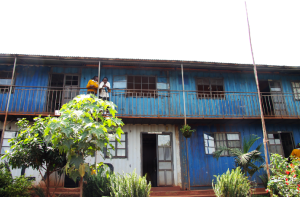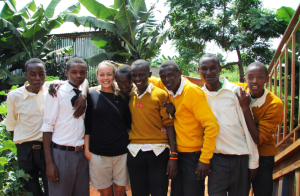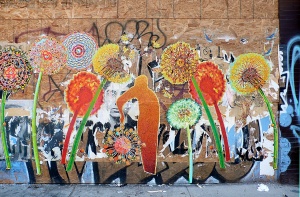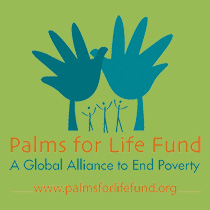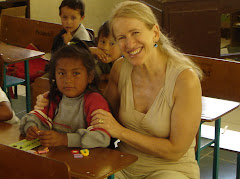Michael Conforti: We are on today. Welcome everybody back to our show called “Notes from the Field,” I’m Dr. Michael Conforti, the Founder and Director of the Assisi Institute, which offers programs in Vermont and Assisi, Italy, which is our home in Italy, for almost 21 years now. And what we have been doing on this radio show is inviting people that have really made a difference in this world; people from the sciences, from the arts, and from the humanities. Today we have a really very special guest; our guest today is Hannah Laufer-Rottman, who grew up in Europe and for many years she worked with the UN with the World Food Programme and from there she’s gone on to be one of the major figures in the world trying to help eradicate world hunger and Hannah thank you so much for agreeing to do this today and welcome to the show.
Hannah Laufer-Rottman: Thank you so much, Michael.
Michael Conforti: Oh you're welcome. I’d like to say in opening, in introducing you to our audience, aside from all of your other talents, Hannah speaks nine languages. I can't imagine how a brain or a psyche could be wired to be that talented and I just spoke with you in Italian and your Italian is as fluent as your Flemish and everything else so that’s a gift. The other thing I want to say, and I remember one of the first times we talked, that really got me so drawn to you and your work; is you told a story where you were working in Africa, I believe you said it was Africa, with people that they literally did not know where their next meal was going to come from. We talk about that, I don’t know where my next meal is going to come from, my next dollar, but you meant that literally. And I wonder if you could talk about that as maybe also being what spearheaded some of your programs, that I know you developed your own nonprofit foundation which I’d love to hear about; but could you tell us a little bit about what that experience must have been like for you, when you literally saw people not knowing where meals are coming from?
Hannah Laufer-Rottman: Well yes, absolutely, thank you so much, Michael, it's a real pleasure for me to be here today. So let me answer a little bit to this first question, just to introduce us and to just bring the subject in the middle of our conversation at once. The hunger that people experience is an every day condition for poor people and very often I say that poverty is the art of survival, because indeed you know that people don’t have enough food on a daily basis; they go out every day without knowing if they will find the food and if they will have a meal on that day. But they somehow survive and today the number that we get of people dying from hunger is relatively low considering that so many people in this world, more than one billion people, suffer from hunger and malnutrition. So many live on less than one dollar a day which is dramatically below the poverty line; so we have a condition for people, for many people in this world who live indeed without knowing where their next meal is coming from, and somehow they survive, and that is the miracle.
Of course, how do they survive and what does it mean for young children to not know where their next meal is coming from? What does it mean for a pregnant woman to not be able to eat the food that she needs in order to ensure her health and the health of her baby? All of this has terrible consequences so talking about this should not be taken in lightly at all. It’s not just knowing where the food is coming from, it’s also realizing that people who live in this condition suffer, unfortunately, damages on their physical and emotional and psychological condition, many of which are totally irreversible. So, the problem of not knowing where the next meal is coming from is, as I said a condition of poor people, to people who completely identify with their condition of being poor, and they go out every morning with a big question mark, will they get the job that day? Will they find the food? Will they, when they go out to their field, will there have been enough rain for them to ensure that they will have something to harvest at the next season.
Many poor people live with all these question marks every day, but somehow they cope, which is absolutely amazing. Of course, when you go to Africa and you go to these very poor communities, you look around, you won't see anybody being obese; you see lots of very skinny people. I don’t say that you see them malnourished to the point where that you see on TV some times, those terrible images, you know, of children when you see just their bones. No, but you see lots of very skinny people, and you see mothers when they breast feed their babies they don’t look as healthy and as full and clean as mothers in other parts of the world where people have enough food so you see all these physical proofs of people being hungry and living with hunger. And as I said, there is also the invisible damage of hunger. And you know, one day, this was not in Africa, this was in Ecuador, I visited a school where we gave breakfast to the children, which they never had before; children would go to school without food, and they would sometimes walk a long way coming down from their communities to the school that is in the valley; sometimes they walk one to two hours just to go to the school, and leaving home where there is maybe no breakfast that day, because people, sometimes have breakfast and sometimes they don’t, and even if they have breakfast, it’s maybe a sweet potato and a tea with a little bit of local sugar. So these kids arrive at school, have nothing to eat in school, and after, of course, half an hour, they’re already starved, and they just live throughout the day with this feeling of hunger. One day as I told you when we were distributing school breakfasts to these children, we gave them just a very highly nutritive biscuit and a glass of a quarter of liter of milk, and I saw all these children during the break at school eating with such an appetite.
Michael Conforti: They were transformed, they had to be, right?
Hannah Laufer-Rottman: They were completely transformed. But then I went to one little kid who spoke perfect Spanish, and I say, in Spanish, “Entonces, estabas con hambre?” means, “So, were you hungry?” And she looked at me with an expression of, “What is this woman talking about?”
Michael Conforti: Oh God, of course.
Hannah Laufer-Rottman: And then I came to realize what it is, Michael. And do you know what it is? People who are hungry and live with hunger and know that since they were born, they have to live with hunger, they don’t experience it as, “I am hungry.” Because you see we, in our world where we have access to food anytime and we never imagine that we would not have access to food, we can say, “I’m hungry,” because we know that immediately after we will have food, so saying, “I’m hungry” is the introduction of, “Now I’m going to have something to eat.” Well, when people don’t know where their next meal is coming from, they don’t express the, “I’m hungry,” because they just live in this state of constant hunger and that’s part of their living condition.
Michael Conforti: What a profound understanding of their life. That really shakes me when you say it that way.
Hannah Laufer-Rottman: Yes.
Michael Conforti: Let me ask you a tough question here: We see on TV these ads for people, starving children and say, “Please give a dollar we’ll feed this child for a week or whatever,” so we see all that on TV. I’m sure many people, a lot of us can grow immune to that, and say, “You know what, here’s another TV show, let me turn the channel, let me watch a baseball game or a comedy, I don’t want to see the face of hunger in front of me.” What do you say to us when we begin to turn sort of a, oh God, almost a cold glance to those images, and also why do we do it? Why do we want to turn away so quickly? Or say, oh yes, what a beautiful young little girl, beautiful little boy, but you know what? There’s nothing I can do. I see the ads all the time, but you know, you lived it. We’re seeing it from the comfort of a living room, eating popcorn, having to finish a nice dinner. How do you help us? I mean you've been in the trenches with these people, Hannah.
Hannah Laufer-Rottman: Absolutely. Michael, that’s a very, very tough question. You know in the international community there is something we call the “donor fatigue”, which is that donors become very quickly uninterested in helping the poor. Look at the Haiti phenomena. In the beginning Haiti was everywhere, Haiti was able to collect millions of dollars to help for the terrible dramatic situation, and now Haiti does not exist any more. And people knew this, people said in a few weeks, Haiti will need more help than ever, but the press, the media will not help us, so we need to find a different way of raising the consciousness and the awareness about what’s going on in the world, so what can I tell you about hunger? You know there is this expression like, if you talk about something impossible, you would say, “Are you talking about ending world hunger?” You know, this is a symbol of something that is impossible to reach. Well, my idea about hunger is that, firstly, food is everyone’s business; access to food, hunger, is everyone’s business. That’s one idea. The second very important statement is, food has to happen today; not yesterday or tomorrow. It has to happen today; it has to happen every day.
So that is just an introduction to the next idea which is yes, the dollar, the two dollars, the three dollars can make a difference today, because people need to eat today so if we need the money to feed the children and just communities altogether, today we need that money. There is of course, a sort of a fatigue among the public, which comes from, why isn't there an end to this problem? Why do we have to continuously give money to feed the poor? Why can't we just stop this hunger once and forever? Well, because it’s not easy, it’s not fast, it’s not going to happen tomorrow, but it should happen. We should also simultaneously, while we feed all these people, be it here in the US (people are hungry in the US), babies, poor people everywhere in the world, we need to realize that we need with one hand to feed those people, and with the other hand, we need to invest in a new way of dealing with access to food so that we can invest in the long term solution. It’s not just one solution, there are many solutions, they all depend on the different situations but there is a way to considerably diminish the risk that people face of being hungry.
Michael Conforti: Is there enough food around? Is it an issue of politics? So before I ask you the question of, you know, can we really end world hunger, why is there hunger?
Hannah Laufer-Rottman: Well you know, you have so many conditions. First of all, you have hunger because of a catastrophe; look what happened in Haiti. But the thing is that in the US if a catastrophe hits, the US has a very solid base, the US is a very developed nation; even if a situation, a terrible drama would occur there would still be a possibility to access food, because the system is solid. But in those very poor countries, a catastrophe like a huge hurricane or an earthquake or a volcano eruption, completely kills the little survival mode in which people use to live. They use all their possible livelihood in a second, so there you need food immediately. This is where we have to bring in food because this is an emergency, people are hungry and it is caused by an external factor.
But there are other conditions. There are some countries where people are hungry because simply they don’t produce enough food. Why don’t they produce enough food? Because sometimes of very, very political conditions. The government hasn’t done what it had to do; the money that was received from international organizations was not invested in buying huge amounts of pumps and drillings to get the water out there which is underneath the earth and with water people could start doing very productive agriculture. There is poverty and hunger, and this, by the way Michael; we talk about hunger as if it were an isolated phenomenon. It is not. It is just one manifestation of poverty, so we should always go back to what is the origin somehow of hunger and you know, poverty has lots of causes and one of the manifestations of poverty is hunger. So people are poor in poor countries, because the country altogether is poor. But sometimes people are poor in countries where it has been a history of inequalities, of unequal distribution of wealth. Some countries, like Brazil for instance, it’s a country that has historically been marked by an enormous exclusion of the poor; for instance, the whole northeastern region of Brazil is suffering from poverty and hunger like the worst places in Africa; and you go down in the region since going down to Rio, the Sao Paulo, and all the south of Brazil, what you see, plentiness; food all over; people are not starving at all; there is an enormous availability of food. Brazil has one of the largest gaps between the rich and the poor. This is historic. That has to change by political actions whereby government insures that poor people have a higher share of the nation’s wealth and once you have a higher income, they will be able to access the food as much as all the other population. So you see there is no just one answer to this, but there are different answers, but you always have to look at what is the cause, what are the underlying causes and then we have to address those underlying causes and that’s the way where we can bring an end to hunger, slowly.
Michael Conforti: And this is really what your own organization, Palms for Life is about, isn't it? It’s an organization, a nonprofit group set up to help either alleviate or address the issue of world hunger. Could you tell us a little bit about your own foundation?
Hannah Laufer-Rottman: Well yes you know that’s a very interesting question Michael, because after having worked for almost 30 years with the UN World Food Program, and having been involved a lot in emergency feeding, but also in what we call development feeding; when I established Palms for Life; when I founded Palms for life, I decided that I would leave to the UN and the humanitarian organizations to deal with distributing food, per se, because it is very expensive, these are big programs and I didn't want to get involved in these kind of programs, but what Palms for Life is doing and why I am so passionate about it, is because we work systematically in those areas where we can address the root causes of hunger and poverty. And we cannot do it all, it’s not that we are going to revolutionize the world, although I hope so, I really would like to have a much more influence on world decisions as I’m having and I will eventually get there; but by bringing our share, I’m sure that we make a difference for many thousands of people. I give you an example. In Burkina Faso in West Africa, one of our projects is to help poor women produce tomatoes and onions. With producing tomatoes and onions, these women can actually establish themselves as a cultural entrepreneurs, because they sell those tomatoes, get an income, and with that income they can buy clothes and food and pay for education of their children. Now there is one trick there; why has it been so difficult for these women?
Michael Conforti: You're saying that they're actually growing this themselves or they’re buying it for other people.
Hannah Laufer-Rottman: No, they grow tomatoes.
Michael Conforti: They grow them; that’s what I thought.
Hannah Laufer-Rottman: And the onions; that’s their profitable business. But you see that’s not enough, because once you analyze what’s going on, you see that these women don’t make as much money as they should make by selling tomatoes and onions. What happens is that they have one handicap; the handicap is that they are not sufficiently organized and industrialized. In other words, when they produce and harvest their tomatoes, they have only so many days where they can sell the tomatoes. Big trucks from neighboring countries come, buy all those tomatoes at a very low cost, and depleting the women from their product, but also giving them peanuts in payment. So the way to overcome this is by going one step further; help these women dehydrate the tomatoes; if they dehydrate the tomatoes, they can keep them, store them, and sell them a little bit further outside of the harvest season, thereby securing a better price and with this better price, their income would be even higher than what they get selling raw tomatoes to the truck drivers that pass by their communities. So that’s just an example of, with a little investment, and with a good understanding of what happens locally, we can make a huge difference.
Michael Conforti: Is that one of your projects; is that one of the projects of Palms for Life?
Hannah Laufer-Rottman: Absolutely. It’s one of the projects, and that’s not a very expensive project, but we impact, these kind of project is a real impact, it’s not just a benefit, it’s an impact. You know, impact means a more long lasting effect. These kinds of project have impact on these people for many many years and even further, once I got to work with these people, I sent a young consultant of ours, who is in Burkina Faso there, and I sent her to the communities, I said, “Go and take the temperature. Talk to these women, see what their needs are.” A few days later, she writes me and she says, “You know, these women work very hard. They don’t have enough agricultural tools. They have to bend over, work in very difficult conditions. If they could have more agricultural tools, their life would be much easier.” And she gave me the list of all the tools these people need. A few weeks later, I got a funding from a local foundation here, about $10,000 and I was able to send this money out there, and they buy now, locally they have bought with this money, all kind of agricultural tools that make the life of these women much easier, make them more productive, and these women at the same time feel empowered; they feel that they can work with dignity; that there is somebody out there that thinks of how to make their life better, treats them with respect. I mean these have enormous consequences.
Michael Conforti: It’s profound how you're changing people’s lives; both the outer world of their life and the inner world, like you say, with dignity and pride.
Hannah Laufer-Rottman: Absolutely.
Michael Conforti: What a contribution you make to the world. If people want to find out more about your organization, make a donation, or maybe even volunteer, how do they get in touch with you?
Hannah Laufer-Rottman: Well very simple, first of course people can go on our web site and there they can find a lot of information on our project, our web site is www.palmsforlifefund.org. People can also write to me, my address is Hannah.Laufer@palmsforlifefund.org and I normally reply very quickly and if people make donations, donations are tax deductible. Just for your information, we have also set up a special construction fund for Haiti. We are not doing anything in Haiti right now, but I am setting up the fund, and I am in touch with local organizations in Haiti and when the moment will come, we will be ready to work with local organization that is serious and that works in the areas that we are interested in. And you know, basically we are interested in education and food production, giving income to women, educating girls, keeping girls in schools. You know, those are all these important problems that will eventually overcome poverty. Because you see they say that when you educate a woman, a girl who has gone through her school, so primary school and secondary education, statistics show that these women, young women, marry later, have less children, send their children to school, and their children are healthier than other children of women who have not been educated.
Michael Conforti: You're changing multiple generations by making that one intervention on the group.
Hannah Laufer-Rottman: Exactly, Michael. Exactly. This is why I say impact; it’s not just effect, it’s an impact. It reaches very deep in these societies and so yes, this is what we do and that’s our passion and if people want to know more, we can talk about this and as I said, people can go on our web site; we have all kind of project. You know the Burkina Faso is just an example, but we have projects in Ecuador, in India, we are now producing a dairy development project, especially for local women in Ecuador. We support water and sanitation project in Swaziland where we help build latrines in schools for girls especially. You know there is so much one can do if you really go in trying to address those root causes of poverty.
Michael Conforti: So even the people that don’t want to dedicate their life to this as you have, they can still make a contribution either financial or otherwise.
Hannah Laufer-Rottman: Absolutely, and as I said, all these contributions are tax deductible and yes, that’s exactly how people can help.
Michael Conforti: Well you know if you want to put a link on our web site, call the office, we would love it; any way we can support it we would love to do it.
Hannah Laufer-Rottman: Thank you so much Michael. That’s really wonderful and I appreciate so much this opportunity and you know, once I get into the subject, it’s very hard to stop me, I’m really passionate about it so.
Michael Conforti: Clearly, you're very articulate and it’s an emotional theme that I’m sure hits so many of us when you're talking. Look it’s so foreign from our lives; I mean, you are living in a world that it’s totally foreign from whether you're European, whether you're American way of life. We’ve all grown up, no matter how difficult our lives are, you knew there was food. We always had in our family, we’d even have 40 people coming to dinner, 60 people, there’s always another box of macaroni, so 15 cents, 20 cents for a box of macaroni, you feed people, but you knew it was always there. I think you're addressing something that is part of the unimaginable in life.
Hannah Laufer-Rottman: That is so true.
Michael Conforti: You've walked in that terrain and you've learned the language of it. And I have you know, the utmost respect to really what you do, I don’t know if I could have done it. You know let me ask you something else, I know I only have a few minutes, because you have to run, you have a very busy schedule, but many years ago I took a trip and I took my son to an amusement park, a big chocolate amusement park, where they had rides and factories, making chocolate, and I don’t want to mention the name, but it’s pretty clear what I’m talking about; and anyway, there was a sight there that I’ll never forget that I don’t know, maybe it’s not polite to speak this way, but let’s try it anyway; I saw these people, I mean obese doesn’t capture what it was. I mean these people, they couldn't even walk any more they were so obese, and they were riding around in these carts; you know, these motorized carts, and you know a lot of them were riding up to the fast food places, for pizza or French fries, hamburgers, hot dogs, and as I think about that now in the context of our conversation today, here you are, you're saying if somebody gets a glass of milk and a couple of oats, or a little bit of fresh fruit, or these kids getting a breakfast for the first time in their life, how do you as a human being Hannah, look at some of these situations, look at the obesity at America and in the world, I don’t want to focus just on America, that’s in the world today, or other parts of the developing nations, and you see this obesity. I mean, America I know is one of the worst. I mean, if you could put yourself in my shoes looking at the theme of this amusement park, literally 400 or 500 pound people riding motorized cars. And I’m not trying to say bad things about obesity, that’s not what I’m saying, but it’s just as juxtaposition to what you've seen.
Hannah Laufer-Rottman: Mm-hm.
Michael Conforti: Could you say something about it?
Hannah Laufer-Rottman: Well Michael, you know that’s a very, very important subject. Just for your information last year, Palms for Life, the only project that we had in the US was a project to raise awareness about hunger in the US that affects 49 million people, of which-
Michael Conforti: How many people?
Hannah Laufer-Rottman: 49 million - 4-9 million people of which 17 million are children.
Michael Conforti: Oh God.
Hannah Laufer-Rottman: So let us not imagine that hunger is a subject that is completely away from America. It is in America as well. It affects, as I said, lots of Americans and we have seen them and we have organizations a contest [ph?] called Faces of Hunger in America because we want Americans to see what’s going on and if you go on the web site, on our web site, Palms for Life, you will see on the right hand, an icon that sends you to a page called “Faces of Hunger in America.” There you can see 14 short films showing hunger and this one woman, for instance, in one of the films the woman says, “There are evenings where I skip a meal in order to feed my children.”
Michael Conforti: Oh my God.
Hannah Laufer-Rottman: So that happens in America. Why do I tell you this? It’s because the subject of food, hunger and obesity, they are all part of one big problem in America, it has different manifestations, but it’s part of a big problem. There is something that does not work properly in the American society. And obesity and I’m not talking about the obesity that is clearly resulting from a medical condition and there is nothing we have to say about this, except that doctors should do their job and take care of these people and treat them for whatever imbalance they might have. But the other part of this uncontrollable way of using food to satisfy something that is deeply missing in the person’s psyche, in the person’s life, that is another aspect of obesity. And I see obesity as a little bit as a sociologist if you wish; as a manifestation of something going wrong in the American society. So I’m not in the blaming mode-
Michael Conforti: No, no, no, I understand.
Hannah Laufer-Rottman: -of saying, “Oh you know, people you are so obese, stop overeating!” That’s not it. I am rather going into what is causing this and when I look at what is going on in the American society and how food altogether is being treated and the relationship that people establish and the relationship the society, the government, everybody has weird relationship to food, and that has to change.
Michael Conforti: Well let me push you for one second again, and I know you have got to run, I’m sorry but I want to get as much as I can out of you, and I hope you come back, I hope you'll agree to come back, you have so much to offer.
Hannah Laufer-Rottman: Thank you.
Michael Conforti: So if you looked at obesity as an image, say a dream image, because you're saying you want to understand it from a sociological point of view, an archetypal point of view, look at the orients say or obesity, how would you frame it? What would you say the central issue is around obesity, when you're trying to get underneath it as you just said?
Hannah Laufer-Rottman: Yeah I think it has to do with it’s the relationship between your body and the outer world.
Michael Conforti: That’s very interesting.
Hannah Laufer-Rottman: And it’s what you put inside your body and what you store inside your body and how you use in a way the food as a symbol of something that you need to get, not to feed yourself, but to satisfy some kind of need, and I can't go too deep into it, because it’s maybe very very complex, but what I want to say is that people who are obese for the reasons that are not the medical reasons, have a relationship to food that has nothing to do with food per se. Because once you have the awareness of what you eat and why you eat, eating is a ritual, Michael, and you know this. Eating is a celebration; it’s a celebration of life, of food, it is seeing food as life, and it is a holy exercise of our every day survival activity.
Michael Conforti: It almost seems like information or the lack of information or faulty information is also a part of this.
Hannah Laufer-Rottman: There is a mixture but there is the other thing, which is many obese people buy a lot of food in the stores because that’s the cheapest consumer item that they can buy and that gives them a sense that they are consumers. The American society wants people to be consumers. And it’s very difficult. I mean those who cannot afford to buy a very expensive car that is advertised might go to the supermarket next door and buy a cart full of food because they need to have the sensation that they are not excluded from the consumer society. That’s one possible explanation and one has to look into all of this. And the whole way the food is being presented to people has to change also. And then the content of the food, when I say the food that is presented to people, do you know how much crap is in food? I mean, people buy food without knowing what they’re buying.
Michael Conforti: I know, I can't eat hot dogs any more. I can barely eat a hot dog anymore.
Hannah Laufer-Rottman: Exactly, so it is what is sick is the offer and the demand, so that the offer is completely distorted; food is not being respected in what is essential about it, what the orient of it, and people don’t see their body in a relationship to food that honors the food and honors the body simultaneously. It has gone away from that kind of dialog, very far away. You know, when you go to restaurants, when you're eating, people say, even it’s very very ironic, even Mexican waiters will tell you, “Are you still working on your food?”
Michael Conforti:
Hannah Laufer-Rottman: I know it’s a very simple expression for many people it wouldn't mean anything. For me, it is an offense. I feel it personally as an offense. I think, “What?” Because I am not working with my food, my food is, I have a different relationship with my food, it’s not working on it, you know? So that’s just an example, but it’s a very important subject, Michael, and there are lots of things behind it and I wish we could make a program and talk to people who are obese and follow them and understand why they, how they live. What happens?
Michael Conforti: With compassion and trying to understand.
Hannah Laufer-Rottman: With compassion and we’d understand and we will discover that there is something very sick in the entire society in the way food is being offered and food is being consumed.
Michael Conforti: Well you know, as we talk, again, I really want to honor you with your time frame today, you got me thinking, I would love to do a public program through the Assisi Foundation and I think Broxtowe [ph?] Borough where we are here, you know, we do programs here and in Europe, but to do one here, because it’s a very active socially minded community, here in southern New England, and west of Massachusetts and I think your work would be received so well, and so I’ll give you a call about this, to try to set something up, you as the speaker for this. And I really want to thank you and I want to say you're truly a gifted woman, and I know it probably sounds funny to hear that; you don’t have to worry about it, I’m saying it to you. You're a gifted woman and you're making a tremendous contribution in the world and I want to thank you very much for taking the time here today and you know, you dedicated your life to this.
